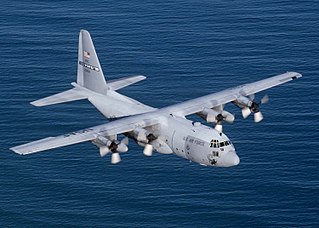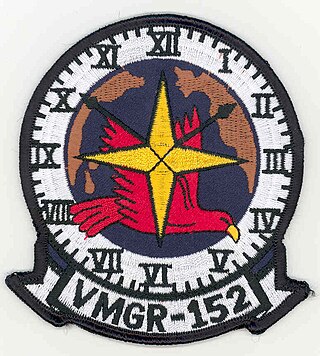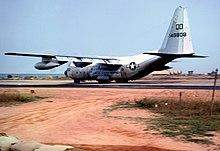
The Lockheed C-130 Hercules is an American four-engine turboprop military transport aircraft designed and built by Lockheed. Capable of using unprepared runways for takeoffs and landings, the C-130 was originally designed as a troop, medevac, and cargo transport aircraft. The versatile airframe has found uses in other roles, including as a gunship (AC-130), for airborne assault, search and rescue, scientific research support, weather reconnaissance, aerial refueling, maritime patrol, and aerial firefighting. It is now the main tactical airlifter for many military forces worldwide. More than 40 variants of the Hercules, including civilian versions marketed as the Lockheed L-100, operate in more than 60 nations.
This is a list of aviation-related events from 1980.

Kai Tak Airport was the international airport of Hong Kong from 1925 until 1998. Officially known as Hong Kong International Airport from 1954 to 6 July 1998, it is often referred to as Hong Kong International Airport, Kai Tak, or simply Kai Tak and Kai Tak International Airport, to distinguish it from its successor, Chek Lap Kok International Airport, built on reclaimed and levelled land around the islands of Chek Lap Kok and Lam Chau, 30 kilometres (19 mi) to the west.
This is a list of aviation-related events from 1968.
This is a list of aviation-related events from 1994.

The Lockheed LC-130 is a ski-equipped United States Air Force variant of the C-130 Hercules used in the Arctic and Antarctic. Ten are currently in service with the 109th Airlift Wing of the New York Air National Guard.

Marine Aerial Refueler Transport Squadron 152 (VMGR-152) provides aerial refueling service to support Fleet Marine Force (FMF) air operations; and provides assault air transport of personnel, equipment, and supplies. The squadron, known as the "Sumos", flies the fixed-wing Lockheed Martin KC-130J aircraft. VMGR-152 is stationed at Marine Corps Air Station Iwakuni, Iwakuni, Japan and is part of Marine Aircraft Group 12 (MAG-12) and the 1st Marine Aircraft Wing.

The Lockheed L-100 Hercules is the civilian variant of the prolific C-130 Hercules military transport aircraft made by the Lockheed Corporation. Its first flight occurred in 1964. Longer L-100-20 and L-100-30 versions were developed. L-100 production ended in 1992 with 114 aircraft delivered. An updated variant of the model, LM-100J, has completed its first flight in Marietta, Georgia on 25 May 2017, and was set to start production in 2018–19.
Riyadh Air Base, formerly known as Riyadh International Airport from its opening in 1946 until 1983, is a military air base in Riyadh, Saudi Arabia. It was originally used by Saudia as an airline hub before King Khalid International Airport opened in 1983.

The Lockheed Martin C-130J Super Hercules is a four-engine turboprop military transport aircraft. The C-130J is a comprehensive update of the Lockheed C-130 Hercules, with new engines, flight deck, and other systems.

The 2009 California mid-air collision occurred at sea, west of San Diego, on 29 October. It involved a Lockheed HC-130H Hercules of the United States Coast Guard and a Bell AH-1 SuperCobra of the U.S. Marine Corps. There were no survivors among the nine crewmates aboard either aircraft.

The Lockheed MartinKC-130 is a family of the extended-range tanker version of the C-130 Hercules transport aircraft. The KC-130J is the latest variant operated by the United States Marine Corps (USMC), with 48 delivered out of 79 ordered. It replaced older KC-130F, KC-130R, and KC-130T variants for aerial refueling. USMC reserve unit, VMGR-452 operated 12 KC-130T aircraft until May 2021; this was the last USMC reserve unit that operated the legacy KC-130s, completing the corps' transition to the more advanced Super Hercules.

On 10 July 2017, a Lockheed KC-130T Hercules aircraft of the United States Marine Corps (USMC) crashed in Leflore County, Mississippi, killing all 16 people on board. The aircraft had the call sign "Yanky 72" and was from Marine Aerial Refueler Transport Squadron 452 (VMGR-452) based at Stewart Air National Guard Base, New York. Debris from the aircraft was found in Leflore County, Mississippi. The USMC released a statement calling the event a "mishap."

On 9 December 2019, a Chilean Air Force Lockheed C-130 Hercules military transport aircraft crashed in the Drake Passage while en route to Base Presidente Eduardo Frei Montalva, a Chilean military base on King George Island in Antarctica.










